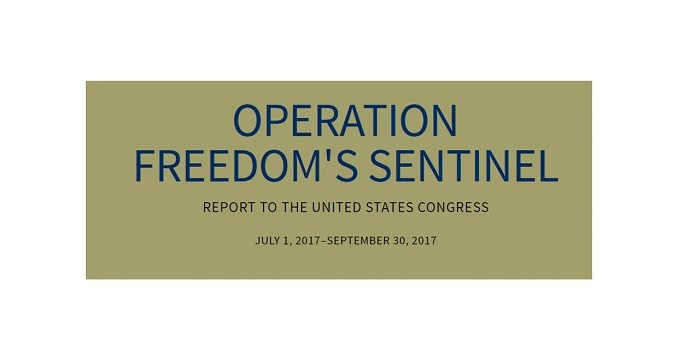
Sep 2017 OFS Report – The Lead Inspector General for Overseas Contingency Operations has published the Operation Freedom’s Sentinel Report to the United States Congress (July – September 2017). This 130-page document describes the activities of the U.S. Government in support of OFS as well as the work of the Department of Defense, the Department of State, and the United States Agency for International Development to promote U.S. policy goals in Afghanistan.
The Sep 2017 OFS report is organized into five strategic oversight areas:
- Security
- Governance and civil society
- Humanitarian assistance and development
- Stabilization and infrastructure
- Support to Mission
Revised U.S. Strategy. The Sep 2017 OFS report outlines the administration’s new strategy for Afghanistan and South Asia. It notes the move from a timeline-based strategy to a conditions-based strategy. The report also notes the change in posture to Pakistan and India; calling on Pakistan to do more to eliminate terrorist safe havens within its borders and for India to provide more economic and development assistance. It also noted the plans to attach advisors to Afghan Army units of brigade and battalion size; moving the advisors closer to the front lines of the conflict.
Security. The Taliban continued their attempts to take control of provincial or district centers but found the ANDSF were quicker this year to respond to those attacks. While the ANDSF seemed to be more successful in the south in 2017 they were challenged in other parts of the country where the Taliban took control of several additional districts.
ISIS-K. The Islamic State of Iraq and Syria – Khorasan (ISIS-K) continues to be a threat in Afghanistan even as their numbers are dwindling. Fighting between the Taliban and ISIS-K has also occurred – mostly in Nangarhar province.
U.S. Airpower. New authorities for the U.S. has resulted in a significant increase in air strikes. There were more air strikes conducted in 2017 than an other year since 2012. Along with the increase in air strikes is a corresponding increase in civilian casualties (from air strikes).
Afghan National Army (ANA). According to current figures there are 170,000 personnel in the ANA. A good percentage of these troops are ‘ghost soldiers’ – either they don’t exist or they don’t show for work. The force has a big turnover of personnel each year. At least 25% of the force are new recruits with no experience and who must go through an initial training period. This raises concerns about the overall effectiveness of the force.
ASSF. The Afghan Special Security Forces (ASSF) continue to be the most effective fighting force within the ANDSF – many times performing missions outside of their special operations mission set. The Afghan government is moving ahead with plans to double the size of the special operations units of the Ministry of Interior (MoI) and Ministry of Defense (MoD).
ALP. The Afghan government would like to increase the size of the Afghan Local Police from 28,000 to 45,000. The increase is subject to ‘conditions’ imposed by the Combined Security Transition Command – Afghanistan (CSTC-A). There are ‘conditions’ attached to the funding provided to the ALP. A Bilateral Financial Commitment Letter links U.S. financial support to reforms and good governance practices within the ALP.
AAF. The Afghan Air Force will also double in size over time and it’s inventory of aircraft will grow significantly. More A-29 Super Tucanos, MD-530 helicopters, and a fleet of UH-60 Black Hawk helicopters are on the way to Afghanistan.
Read or download the Sep 2017 OFS Report –
Operation Freedom’s Sentinel Report to the United States Congress, July 1, 2017 – September 30, 2017, Department of Defense Officer of Inspector General.